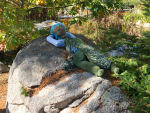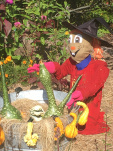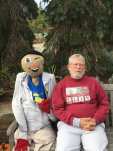Kathy Lynn Emerson's Blog, page 30
October 23, 2017
Me and those Guys in Black Suits
Lea Wait, here, thinking about how incidents years before can influence scenes an author writes now.
For example: in my PIZZA TO DIE FOR there’s an Italian restaurant in New Jersey with a back room where “men in black suits” hang out. Stereotypical? Perhaps. But let me tell you a story …[image error]
When I was in my mid-twenties I lived in Greenwich Village and was married to a comedy writer. You’d recognize the names of most of those he wrote for. One was Rodney Dangerfield, who also owned Dangerfield’s, a small nightclub on New York’s East Side, where my husband (and often I) spent a lot of late nights.
When we needed a car, my husband borrowed Rodney’s limo. When Rodney was invited to perform or even appear somewhere outside his club, he felt more secure if my husband and I, and his manager and his wife, went with him.
On one such night we all piled into Rodney’s car and headed uptown. Rodney cautioned us, “Don’t talk about business. This guy, he runs numbers and girls in the Bronx. None of our business.” Then he turned to his current girlfriend. “And don’t be telling anyone your last name, or where you’re from.”
We all knew her father was the chief of police in a major East Coast City.
The tone was set for the evening.
The car stopped at a small Italian restaurant close to (and almost beneath) the Cross Bronx Expressway. It wasn’t an elegant location. The building was shabby, and the restaurant only had two rooms and a kitchen.
The tables in the front room had been arranged in a line and set for only one party: the six in our car (Rodney, his girlfriend, the manager and his wife, and my husband and I) and four other men (in black suits) who joined us.
We could see other men in black suits seated in a room in back of ours. But no other diners arrived while we were there, and no one left. I was seated next to a heavyset man perhaps in his fifties, who was at the head of the table and clearly in charge. (“Hey, the blonde can sit here, next to me.”) I have no recollection of what we ate, although I’m sure it involved pasta.
He asked my husband and I how long we’d been married (a short time) and drank several toasts to us. He asked what I did. At the time I produced and was talent for a daily corporate CCTV show. He nodded in appreciation and then asked, “You got any problems with your boss there?”
I assured him I did not.
“Well, if you do. If you got any problems, you let me know. You’re a nice young couple. You shouldn’t have any problems,” he concluded, draining another glass of wine.
The dinner didn’t last long: Rodney had to get to his club to perform. I never asked who our host was, although I saw him at Dangerfield’s a few times after that.
But when I wrote PIZZA TO DIE FOR, a funny mystery about a fourteen year old girl who finds out her family is “connected,” those men in black suits in the back room came back to me.
I suspect they weren’t as funny in real life as I depicted them in my book. But, yes: they were real.
I didn’t realize at the time that years later I’d write a mystery, and they would have roles in it. But all experiences, and memories, are fodder for a writer …


It Ain’t Always Winter in The County
Vaughn
Whenever I tell people that I live in THE COUNTY their first response is “It’s so cold up there and the winters are sooo long!” This is not always the case. I spend a lot of time riding my ATV on the hundreds of trails and woods roads where ATVing is allowed. Without a doubt late September and early October is the optimal time for this.
In the past week I’ve been fortunate enough to have encountered several moose, two black bears, and numerous partridge. I use the excuse that I’m going bird hunting, but the truth of the matter is I consider a good HUNT one in which I see birds, shoot at several, but kill none.
The following photos are the real reason why I do it
[image error]
One Reason Why I’ll Never Sell My ATV
[image error]
It’s true that fall has its downside (Like what follows) but I still look forward to it every year. The crisp, sometimes frosty mornings followed by sunny days when the temperatures reach the upper sixties and lower seventies (although this year we’ve had several days in which the National Weather Service has posted temps in the eighties) are idyllic. When people ask me what is the best time to visit I send them the pictures above.
Anyone up for some Bird Hunting?


October 20, 2017
Weekend Update: October 21-22, 2017
[image error]Next week at Maine Crime Writers, there will be posts by Vaughn Hardacker (Monday), Lea Wait (Tuesday), Jen Blood (Wednesday),Barb Ross (Thursday), and Susan Vaughan (Friday).
In the news department, here’s what’s happening with some of us who blog regularly at Maine Crime Writers:
from Kaitlyn Dunnett/Kathy Lynn Emerson: I’ve been updating my webpages, including the list of all my books. If you’d like to take a peek, each of the websites is just my name .com and the list is at http://www.kathylynnemerson.com/booklist.htm
Saturday the 21st (TODAY) Kate Flora and Gerry Boyle will be at the Barnes & Noble in Newington, NH from 1-4 as part of a benefit for the Rice Public Library. Stop and say Hi if you’re in the area. Genevieve Morgan and Melissa Kim will also be there with their childrens books.
Kate Flora and Joseph K. Loughlin will be launching their new book about police shootings, Shots Fired: The misunderstandings, misconceptions, and myths about police shootings this coming Thursday at DiMillo’s in Portland, from 5-8 p.m.
Planning ahead? Next weekend, October 28 and 29, Barbara Ross, Kate Flora and Lea Wait will have a booth at the 2017 REM Craft Fair, Champions Fitness Club, 30 Elm Plaza, in Waterville, Maine, 10am-5 pm Saturday the 28th, and 10am until 3 pm Sunday, October 29. Dozens of Maine vendors will be selling food, clothing, crafts, jewelry — and wonderful Christmas items, for you, or for gifts. Com’on over! (Signed books make great gifts!)
[image error]
Interested in sampling some police procedurals and thrillers for free? Kate Flora’s publisher is doing a promotion from the 24th to the 30th of October. Here’s the link: http://mailchi.mp/ebookdiscovery/9-free-police-procedural-mystery-thriller-ebooks
An invitation to readers of this blog: Do you have news relating to Maine, Crime, or Writing? We’d love to hear from you. Just comment below to share.
And a reminder: If your library, school, or organization is looking for a speaker, we are often available to talk about the writing process, research, where we get our ideas, and other mysteries of the business. Contact Kate Flora


Harvey Weinstein: Sex Crimes, Conspiracy of Silence & what it Means for Writers
[image error]“Everyone in Hollywood knew.”
This is the common refrain now coming out of Tinseltown since Harvey Weinstein’s hideous crimes have come to light. So what does that mean to writers, especially writers of crime fiction?
As a writer myself, I’d be hard pressed to create a villain as despicable as Harvey Weinstein. The man was a monster, both physically and emotionally. He masked his behavior in sheep’s clothing sewn out of righteousness, political correctness, art, power, and Oscars. All the above conspired to hide his monstrous acts. That and the conspiracy of silence those in Hollywood took part in. In many ways, it is very similar to the conspiracy of silence the Catholic Church practiced when priests were abusing children.
But how can something like this happen in this day and age unless there was NOT a massive conspiracy to keep his crimes quiet? We’re supposed to be an enlightened populace. We’ve supposedly learned from previous eras, where the casting couch was as common as an audition. We’ve been lectured repeatedly about sexual harassment in the work place and the meaning of the word ‘no’. So what gives?
And how does all this impact us as writers?
Here’s the thing about crime: it flourishes in a vacuum. Now, depending on the crime, that vacuum can be lax bank security. A museum without adequate security. A woman walking home alone at night. Young boys from broken families left alone with predatory priests. Little to no loss prevention officers at your local Target. Crime will always flow to the most vulnerable areas in society.
Harvey Weinstein knew this about criminal vacuums and used it to his advantage. He had power and money in spades, and knew instinctively that we live in a culture that idolizes celebrities. He knew there were women who would accede to his lascivious demands in exchange for unlocking the door leading to fame and fortune; because he held the key. And the ones who protested, either vocally or to the police, he could stifle through legal maneuvers and brute power. He could ruin a young girl’s career if he wanted, and he often did. The lack of controls on this monster allowed him to continue his crimes undetected for years.
So then we ask why so many women failed to speak up about him? And why some continued to remain on friendly terms with him despite knowing what he was like? Why did they thank him after winning an Oscar? Were they afraid to lose their careers? Did they believe it was futile and that there could be no legal case made against him? Why did they remain silent? Is this just yet another sad aspect of human nature? That some people will do anything to become famous. One big name actress even told all her friends what happend to her and they advised her to forget about it. That it was only Harvey being Harvey.
Huh?
And politics aside (and I truly do mean this in an apolitical way) did his advocacy for liberal causes provide him a moral front for his criminal behavior? He said the right things, donated money to the proper causes, as well as helped pay for Bill Clinton’s legal defense in the Monica Lewinsky case (to the tune of $10,000). Power, access, and political correctness further insulated his violent criminal deeds, and allowed the vacuum to prosper and grow, and provide a front for his criminal behavior.
Many say Weinstein is merely the tip of the iceberg in Hollywood and that other big wigs will soon be exposed. Corey Feldman was ridiculed for saying there were child predators in Hollywood. Does it happen in other industries? Of course it does. There’s Roger Ailes, Anthony Weiner and Bill O’Reilly. It happens all the time in politics and in the music industry. It happens in religious organizations, as evidenced by the Catholic Church (I grew up Catholic and one of our parish priests was a predator). Any industry or group that promotes celebrity worship and power gives rise to sexual harassers, rapists, and predators.
Celebrity + power + conspiracy = criminal vacuum.
It takes brave people to stand up against the entrenched power structure and call them out on the red carpet. It takes teachers and parents to teach kids to work hard and not succumb to celebrity worship and the easy path to fame. But I fear that this will prove difficult in this day and age, although I hope I’m wrong. Living in a culture that idolizes celebrities and treats them as demigods, there will always be a few who’ll do anything to be famous. Sell their soul to a Weinstein. Let’s hope we can fill this vacuum and prevent anymore Weinstein’s from happening. Let’s speak up and expose these villains.
I have children and want this begavior to finally end. In the future, I only want to read about such villains in crime novels not newspapers and use them in the plots of my crime novels. As writers, it’s our job to get out the truth.
Joseph Souza’s domestic thriller THE NEIGHBOR (Kensington) comes out April 24, 2018 [image error]


October 19, 2017
The Importance of a Great First Line
Dear readers:
Dorothy Cannell is suffering from a pinched nerve and cannot blog today, so instead we [image error]share some responses to a Facebook question: Please share a favorite first line from your book or someone else’s. Kate Flora led off with the opening line from Led Astray: Burgess wished he could have slapped the little shit silly.
What makes a first line work? What draws you in? Please add your favorites in the comments, and keep an eye on our weekend updates and our Facebook page, where interesting questions for you may pop up.
Terrie Moran First line of Well Read, Then Dead: “Oh, pu-leeze, Rowena, Anya Seton never measured up to Daphne du Maurier’s elegance. I’m shocked you would say such a thing.” Jocelyn Kendall, pastor’s wife and book club gadfly, crossed and recrossed her legs in perfect tempo with the ever-increasing meter of her rant.”
Dottie MacKeen Geneva Sweet ran an orange extension cord past Mayva Greenwood, Beloved Wife and Mother, May She Rest with Her Heavenly Father. Bluebird, Bluebird – Attica Locke
[image error]Earl Brechlin The light is different in the north, far above Bangor, up beyond Greenville in the realm of townships with numbers rather than names, where moose outnumber people, where thundering double-trailer logging trucks reign supreme on tracks of dirt, dust billowing behind them like the wake of a nameless ship fading across the surface of a deep and unexplored sea. (Earl didn’t attribute this, but inquiry reveals it is from a forthcoming book of his nonfiction)
Sandra Neily “Where’s Papa going with that ax?” said Fern to her mom as they were setting the table for breakfast. “Charlotte’s Web,” E.B.White
Mary Ellen Hughes First line of Scene of the Brine: Bang!
Rick Helms First line from VICAR BREKONRIDGE: “Had Edward Drummond worn a thicker, heavier overcoat, he might have lived.”
Joyce Tremel First line from TO BREW OR NOT TO BREW, the first book in the Brewing Trouble series: “If looks could kill, the plumbing inspector giving me the bad news would have been in big trouble.”
Hank Phillippi Ryan From Air Time: It’s never a good thing when the flight attendant is crying.
Les Roberts First line of my first novel, An Infinite Number of Monkeys: My ficus benjamina was dying.
Valerie Lentz Horowitz “Christmas won’t be Christmas without any presents!” (Amy, Little Women.)
Robert Lopresti “On my naming day when I come 12 I gone front spear and kilt a wyld boar he parbly ben the last wyld pig on the Bundel Downs any how there hadn’t ben none for a long time befor him nor I aint looking to see none agen.” – Russell Hoban, RIDDLEY WALKER
LynDee Stephens Walker Julia Spencer-Fleming still holds my “best first line ever” trophy. From IN THE BLEAK MIDWINTER: “It was a hell of a night to throw away a baby.”
Polly Iyer From Hooked:If Linc rated high-priced call girls on a scale of one to ten, [image error]Tawny Dell would score a twelve.
Katie Caprero “I poisoned your drink” from Duane Swierczynski “The Blond”
Gretchen Asam How about Anthony Burgess’ Earthly Powers? “I was in bed with my catamite when the archbishop came to call.”
Vicki Lane From my ART’S BLOOD — second of the Elizabeth Goodweather books. “I still see the bed — its wide white expanse floating like a snowy island on the deep pearly carpet — the creamy tufted silk coverlet neatly folded back — the soft heaped pillows, their pale lace soaked and stiff with her blood.”
Laurie Graves From my own “Maya and the Book of Everything”: “The first time Maya Hammond saw the man who didn’t smile, she and her mother, Lily Turcotte, were on a train going from Boston to New York.”
Susannah Charleson From my next book, FAITHFUL: NOTES FROM THE SEARCH FOR MAN’S LOST BEST FRIEND.Puzzle wakes me with her going.
A favorite by someone else: Erik Larsen’s DEVIL IN THE WHITE CITY: How easy it was to disappear: A thousand trains a day entered or left Chicago.


October 17, 2017
The part of the writing process that makes people run screaming
Even my dog didn’t want to hear about my works in progress.
The writing process is a weird and wonderful thing. Every writer has his or her own process. Want to know what a writer’s process is? Just ask, writers will talk about it endlessly.
It’s similar to when you ask a golfer how the game went, hoping for a “good” or “bad” and instead get a hole-by-hole, stroke-by-stroke account that makes you want to do a Colonel Mustard with a putter.
I’ve been thinking about writing process as NaNoWriMo approaches. Oh, you don’t know what that is? It’s the National Writing Month challenge – write 50,000 words by the end of the month. Presto! You’ve almost got a novel. You register, do all sorts of other things. I’m not clear, because I don’t do it.
I saw that the Waterville Public Library is having Wednesday “write-ins” for writers who are taking part. These hour-long sessions, I’m guessing, are more support group and rap session than writing. Sorry, library, if I’m getting it wrong. I just can’t see getting a lot of actual writing done in an hour with a bunch of other writers around, even if it’s in a nice quiet library.
Not that that’s a bad thing – I mean the support group and rap session. Many writers, including me, have taken part in writer groups, which not only provide feedback but also give writers a chance to talk things out.
One thing I’ve discovered about my writing process is the need to talk it out. I have to talk out backstory, plot – hear it, let it develop verbally. I didn’t decide that part of my process, it’s just something that I realized. It’s weird, right?
And, frankly, it’s not easy. I don’t mean the talking part. I mean the finding the right person to listen part.
Writers may understand – when you try to talk out your plot or character background to people, it’s often like telling someone about your golf game. You see the eyes of the listener glaze over, the lack of interest. The confusion. The panic when they think, listening, that your book is going to truly suck because the lengthy convoluted story you’re telling them seems to have nothing to do with what they thought the book was about.
Just as bad is when they start rewriting it for you, which is one reason I don’t want to have another writer as my sounding board for this part of the process.
I don’t want to be derailed. I don’t want to debate whether a plot point is good, or whether the character would actually say or do that. I want my brain to go where it needs to go to work it all out without interference. So, I’m not looking for advice so much as someone to bounce it off. And by bounce it off, I mean they listen with understanding and comprehension, making appropriate points when needed.
That person, I can tell you from experience, is not easy to find. (No offense to anyone I’ve talked about details with my book, and you know who you are). My sister suggested I hire a sex worker who’d just sit and listen to me talk about my book, but I can see a lot of pitfalls in that. In fact, it wouldn’t be much different from the issues I have now, except I’d be losing money in the process.
I’m not looking for an answer here, or advice, or sympathy. I’m just talking it out. Thanks for listening.


October 16, 2017
A Magical Day in the Garden
Kate Flora: Here at Maine Crime Writers, we don’t always talk about writing. One of our [image error]goals is to bring you “all things Maine” and share some of the places, and events, that we find special and hope our readers will, too. The Coastal Maine Botanical Gardens are not a new subject for this blog, I’ve mentioned them before, and so has Barbara Ross. Today, the subject is a bit different: butterflies, scarecrows, gardens in the fall, and in particular, the beyond wonderful Bibby and Harold Alfond Children’s Garden.
Looking for a way to spend a lovely fall day? Grab yourself a child and head to the gardens. Especially for fall, the gardeners have assembled wonderful collages of flowering plants, grasses, pumpkins, squash, and gourds, like these.
Scarecrows are everywhere, and they are endlessly creative. They hang from the windmill, tend large tin tubs, recline on the rocks, and lean against the trees, playing their drums.





Even though it is mid-October, the mild fall means that many flowers, especially annuals, are still in bloom, and those blooms are abuzz with busy bees and the amazing delicacy of butterflies. Worried about the Monarchs? They are everywhere here. Wondering what those butterflies that look like little Monarchs are? Those are your painted ladies. Amidst the bees and butterflies, the ponds attract a variety of dragonflies.
[image error] [image error]
Some of the fun things to do with your child? There is almost too much to do. At the entrance to the children’s garden, there is a quote from Barbara Cooney’s Miss Rumphius engraved in the stone. “You must do something to make the world more beautiful.” There is no doubt that the Alfonds and other donors have done that here. More beautiful, magical, and engaging.
Walk past the spouting whales. Take tea in the little tea house. Go rowing in Burt Dow’s boat (from Robert McCloskey’s Burt Dow: Deep Water Man) or stroll past Mr. McGregor’s garden and see Peter’s blue coat. See little bear and Sal’s spilled pail of berries from Blueberries for Sal. Go up in the tree house and walk the rope line. Don’t worry. You can’t fall.


That is just one small corner of the garden. After the children’s garden, there were scents and textures and a chance to stick your head in a stone and hear your voice thunder. Black petunias (at the small child level, so guess who saw them?) and sculptures moving in the wind like silver birds. And because our small child had a camera, there was pond to photograph frogs.
[image error]
Did I neglect to mention the amazing flowers? Globe Thistle and Love Lies Bleeding and other jewels of the late season?




This is a place to visit again and again, season after season, to watch the botanical world change. Maybe next time, I’ll see you there.


October 15, 2017
Over 2000 Women and Still Adding More (and a giveaway)
Kaitlyn Dunnett/Kathy Lynn Emerson here, today writing as Kathy. As some of you know, under that name I write (mostly) historical novels set in the sixteenth century. My interest in that period of history and the women who lived in England back then dates from my childhood, when I read a YA biography of Queen Elizabeth the First. By the time I was in college, I was fascinated by the stories of other influential Tudor women and when I finally took the plunge and sat down to write my first full length novel, I chose to set it in the 1550s.
[image error]
It didn’t sell. Neither did any of the fiction I wrote during the late 1970s. But in the process of learning my craft, I accumulated file cabinets full of notes and shelves full of books about sixteenth-century England. It was soon obvious to me that, for the most part, details about the lives of sixteenth-century women had been relegated to a sentence here and a footnote there. Often they were identified only as someone’s wife or daughter. Frequently their first names were omitted. Given the number of marriages some women made, an individual could go by a number of surnames and titles in the course of her lifetime, but in many cases no one made the connection between those names. If they had, they’d have realized what interesting lives a lot of sixteenth-century women led.
[image error]
It seemed to me that it would be helpful to have a reference book that sorted out their identities while also providing a starting point for others to do further research. Since no one else had written one, I decided to tackle the project. My proposal for a book on Tudor women went through several incarnations before finally evolving into a who’s who format. In 1980, after many rejections (“Not scholarly enough”; “Too scholarly”; and my favorite, “Not feminist enough”) I sold the concept to a small scholarly press. It was my first sale. There was no advance. In hindsight, I know that I signed a very disadvantageous contract, but I was still a pretty happy camper. The book was published in 1984 as Wives and Daughters: The Women of Tudor England.
[image error]
It is both a good thing and a bad thing that the 570 entries in Wives and Daughters eventually became outdated. What’s good is that interest in women’s studies expanded and new discoveries were made. Some of them contradicted what scholars thought they knew. Printed material that was difficult to get a look at in the 1970s is readily available today through electronic search engines, expanding our knowledge even further. The bad part? For decades, I couldn’t do anything about updating my book. It wasn’t until the publisher finally went out of business that my rights were returned to me. At that point, I began updating the entries and adding new ones and created my online A Who’s Who of Tudor Women. On the premise that they were for educational purposes only (I wasn’t charging money for people to view the information) I included portraits and photos of monuments when I could find them.
[image error]
Fast forward to 2017. Now that I’m no longer writing under the Kate Emerson pseudonym, I’ll be letting that domain name expire at the end of the year. Since that’s where the Who’s Who has been housed, I’m now in the process of launching a new website for my Tudor women biographies. Since art historians keep changing their minds about the identities of subjects of portraits, and since copyright issues are always tricky, I’ve decided to eliminate the illustrations. Anyone who is interested in a particular woman can find her portrait somewhere on line or in a book, just as I did.
[image error]
Compiling A Who’s Who of Tudor Women has been my hobby for decades. And yes, I admit it, it’s also something of an obsession. At last count, there were 2,278 entries. The Who’s Who was never intended to be a scholarly undertaking. I give some sources, but by and large the entries are still compiled from fleeting mentions of the subject in a wide variety of places. If I included footnotes, they would take up more space than the mini-biography itself. As I said earlier, I intended them to be starting points for more serious research.
[image error]
Unlike writing a single book, this is a project with no end. Every time I start research for a new historical novel or short story set in the sixteenth century, I discover more interesting Tudor women. Over the years, I’ve also met several similarly obsessed scholars and numerous genealogy buffs. They often share their latest discoveries with me.
[image error]
What about you, readers of this blog? Are you obsessed with some sort of research? Even if you aren’t writing a book, it’s easy to get hooked while climbing your family tree. Or maybe you read everything you can find on some arcane subject. Share, please, and one lucky person who comments on this post will win an advance reading copy of X Marks the Scot (written as Kaitlyn Dunnett and in stores November 28), in which Liss MacCrimmon and her friends embark on a research project of their own.
[image error]
Kathy Lynn Emerson/Kaitlyn Dunnett is the author of more than fifty traditionally published books written under several names. She won the Agatha Award and was an Anthony and Macavity finalist for best mystery nonfiction of 2008 for How to Write Killer Historical Mysteries and was an Agatha Award finalist in 2015 in the best mystery short story category. She was the Malice Domestic Guest of Honor in 2014. Currently she writes the contemporary Liss MacCrimmon Mysteries and the “Deadly Edits” series (Crime and Punctuation—2018) as Kaitlyn and the historical Mistress Jaffrey Mysteries (Murder in a Cornish Alehouse) as Kathy. The latter series is a spin-off from her earlier “Face Down” mysteries and is set in Elizabethan England. New in 2017 is a collection of short stories, Different Times, Different Crimes. Her websites are www.KaitlynDunnett.com and www.KathyLynnEmerson.com
[image error]
Were you wondering about the women featured in the portraits? Imagine how frustrated I was when I couldn’t identify someone mentioned in a footnote. The illustrations above show:
monument to Dorothy Bampfield, Lady Dodderidge of Barnstaple, Devon (d.1615) in the Lady Dodderidge Chapel, Exeter Cathedral
portrait labeled “Duchess of Chandos” and attributed to John Bettes the Younger, 1577 in the Paul Mellon Collection. The Chandos title is that of baron not duke. The subject is currently thought to be Frances Clinton (d. 1623), wife of the third baron.
The Cholmondeley Sisters with their babies, supposedly born on the same day. There is debate over their identities. The portrait was painted between 1600 and 1610 and is in the Tate.
portrait of Mildred Cooke, Lady Burghley (1526-1589), probably while pregnant with her son, Robert Cecil, in 1563, attributed to Hans Eworth and located at Hatfield House
stained glass window in Arundel Cathedral, West Sussex, showing Anne Dacre, Countess of Arundel and Surrey (1557-1630)
monument in Westminster Abbey to Elizabeth Russell (1575-1600), goddaughter of and maid of honor to Queen Elizabeth and daughter of the notorious Lady Russell who kept Shakespeare’s company from opening a theater in the Blackfriars precinct of London.
detail of a family tree created in 1597 for the Heskeths of Rufford showing the two wives of Thomas Hesketh (d.1523), Elizabeth Fleming, from whom he was divorced in 1487, and Grace Towneley (d.1510)
sketch by Hans Holbein the Younger, probably of Mary Zouche (c.1512-after 1542), maid of honor to several of Henry VIII’s queens.
detail of memorial brass in St. Giles, Noke, Oxfordshire, showing Joan Hurste (d.1599) and her daughters by her second husband, Henry Bradshaw. He and her sons are also shown on the memorial brass, as is her first husband.


October 13, 2017
Weekend Update: October 14-15,2017
[image error]Next week at Maine Crime Writers, there will be posts by Kaitlyn Dunnett/Kathy Lynn Emerson (Monday), Kate Flora (Tuesday), Maureen Milliken (Wednesday), Dorothy Cannell (Thursday), and Joseph Souza (Friday).
In the news department, here’s what’s happening with some of us who blog regularly at Maine Crime Writers:
Lea Wait will be visiting students at the Hermon Elementary School in Hermon, Maine on Wednesday, October 18.
An invitation to readers of this blog: Do you have news relating to Maine, Crime, or Writing? We’d love to hear from you. Just comment below to share.
And a reminder: If your library, school, or organization is looking for a speaker, we are often available to talk about the writing process, research, where we get our ideas, and other mysteries of the business. Contact Kate Flora


TEG MORF REDNU
John Clark with a slightly different look at literature. It all started when the above cryptic phrase swam up from the memory pool. How many books are published annually? The best answer I found is this: There are somewhere between 600,000 and 1,000,000 books published every year in the US alone, depending on which stats you believe. Scary, eh? As a compulsive reader (238 thus far in 2017), I’m prone to accumulating far more than I could possibly read. In fact, I’ve started working on accepting my powerlessness over books and triaged the monster TBR pile in my bedroom, the computer room and the closet in our back bedroom. As a result, close to 300 books are headed to other libraries on my sharing list across Maine. That doesn’t mean I won’t relapse, but I’m trying to do more with the eight page borrow from other libraries list on my computer. see image below.
[image error]
Anyhow, when the above three words surfaced the other morning, I started thinking about the timeline of books that have remained with me in memory form over the years. When we were little, our parents read to us almost every night and among the books that stand out from those years, perhaps Stuart Little and the trio by Ruth Styles Gannet (My Father’s Dragon, Elmer and the Dragon and The Dragons of Blueland) stand out. From ten or so until I went off to college, I devoured plenty of books, thanks to the Vose Library in Union as well as ones I found while exploring my grandmother’s home in New Portland. I suspect my late uncle Leland Look’s love of hunting, fishing and trapping in and around New Vineyard may have influenced some of what I read, as there were numerous series about brothers and cousins and best friends many of whom roamed the outdoors of Maine. What really hooked me in my teen years were the books of Edgar Rice Burroughs. Everyone remembers him for the Tarzan books, but he wrote many others and I’m pretty certain I read every one of them. I was particularly intrigued by his ending almost every chapter with a mini-cliffhanger, going to a different character in the next and ramping up the suspense for page after page before resolving what was whirling in the back of the reader’s mind.
[image error]
Burroughs’ work funneled me into serious science fiction and fantasy. A.E. Van Vogt, L. Sprague De Camp, Harry Harrison and Isaac Asimov all took me to places that were far more interesting than my high school was. Slan and The Incompleat Enchanter are titles that still resonate in my brain today.
[image error]
We got a lot of the books accumulated by my Clark grandparents. Among them four stand out some fifty years later and were the origin of the title of this piece. Sewell Ford wrote lots of books, but I fell in love with his Torchy series. They featured a poor fellow named Torchy who worked in the mailroom of a New York company. When he encountered Miss Vee (Veronica), the owner’s daughter, sparks of the old fashioned kind erupted and over a series of books, Torchy and Miss Vee developed as dandy a romance as you’d want to read about. In Torchy Private Secretary, Torchy found a note that said “Grebel out. Larkin melding. Teg morf rednu.” He asked a card playing friend who explained the rules of penuchle. The upshot was that Miss Vee’s aunt was about to be fleeced in a stock deal. Torchy saved the day by convincing a young dandy to let him fly over the yacht where Miss V and her aunt were cruising and dropped a ripe melon with a note warning them not to sign papers completing the deal.
[image error]
The other book was George Barr McCutcheon’s Brewster’s Millions. Later made into a movie starring Richard Pryor. I liked it because of the novel idea that Brewster had to spend one million dollars in a year (back in the early 1900s) and have absolutely nothing to show for it. He was forbidden to tell anyone why and would lose a much larger inheritance if he did. The ways in which he blew it, how he had to evade being institutionalized and avoid losing his lady friend made it a dandy read.
[image error]
Who knew Miss Agnes came in two colors?
[image error]
Next up were some great mystery series. I devoured the Travis McGee series and fantasized about having my own Miss Agnes, did the same with Ross McDonald and early Spencer before discovering Tony Hillerman. Jim Chee and Joe Leaphorn can be my neighbors any time. Ditto David Robicheaux and Matthew Scudder.
Each of these books and authors had a hand in creating how I see the world and think today. Most I probably won’t read again (Curse you TBR pile), but parts of them live in my head to this day. What does your literary timeline look like?





